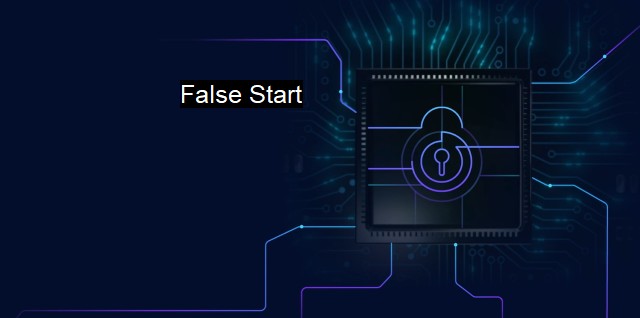What is False Start?
Understanding False Starts in Cybersecurity: The Struggle between Antivirus Software and Legitimate Software Applications
A "false start" is a term that has evolved with the development of technological innovation. This term refers to instances in which an antivirus program mistakenly identifies authorized or legitimate software as a potential threat and blocks it from functioning. In simpler terms, it is an unexpected conflict between the antivirus program and a legitimate software application that the antivirus program wrongly identifies as a potential cyber threat.False starts have become an increasingly prevalent problem in the area of cybersecurity, especially in the last two decades. As digital systems continue to evolve, so too do the ever-present threats that lurk in the digital realm, such as malware, spyware, ransomware, and other types of cyber threats. To combat these threats, cybersecurity companies have developed antivirus software that can detect potential threats on a user’s device. The problem is that these programs often identify otherwise benign applications as viruses, which can cause false alarms and unnecessary trouble for users.
One common cause of false starts in cybersecurity is attributed to differences in the programming and detection algorithms that the antivirus software uses. Antivirus systems operate under a heuristic system: They analyze incoming data packets and look for specific signatures and behaviors that match known cybersecurity threats. if the programming and algorithms of the heuristic analysis dictate different behaviors and alert triggers from legitimate programs, they may falsely identify APIs or portions of the codes as viruses, resulting in erroneous flagging and other actions that disrupt software functionality.
Another common cause of false starts in cybersecurity is attributed to configuration errors in the antivirus systems. Antivirus programs are usually meant to integrate seamlessly with running operating systems and applications, but it is crucial to ensure that configurations and versioning are up-to-date. Using outdated system resources or adding incompatibilities with firewall/security settings may regress the efficacy of the antivirus software, resulting in false detections and stopping of executable processes.
The consequences of false starts are often costly, both in monetary and operational costs. False alarms or other erroneous cybersecurity alerts can cause inappropriate software shutdowns, lost data, frozen applications, and many other frustrations for the end-users. users often have to spend a lot of time tracing back the source of the alarm, such as information warnings logging event IDs, only to realize the warning was unwarranted. If one lacks hacking knowledge, disposing of in-authentic alarming processes may result in compromising host systems or worsening compatibility disruptions.
false starts in cybersecurity often lead to a decrease in the public’s trust in antivirus software companies. If false alarms or harmful alerts become too prevalent, users may begin to lose confidence and grow disillusioned with a given cybersecurity services company. This factor especially affects regular software developers who cannot invest resources to deal with checks on the antivirus platform while releasing runtime private-usage of various Windows DLL, seeking to develop it into a wider distribution.
To combat false starts, cybersecurity companies must invest in sophisticated threat analysis, comprehensive testing, risk-based filtering of the system calls to minimize alarms raised, and continuous staff training. Companies standing at the forefront of handling False alarms do vital Beta testing using their staff or users to demonstrate the potentials of their new updated systems. Automated or Rule agent-based behavioural monitoring (for multi-level interfaces and trained insider detection for transactions) solutions also are fresh by the usage of industry standard Digital Transformation and ethical hacking techniques.
a false start results when a prosecutor incorrectly detects a legitimate file as a viral threat, which has ramifications that is either financially draining in management or disrupts legitimate tasks if productivity suites or granted a degradation from an automatic temporal point of auditing before the damage is done in probable-rarest escalating interprocessing of invalid flags/configurations. competent application of latest technologies by cybersecurity firms and continuous monitoring of antivirus settings and algorithms can help reduce the severity of false starts in cybersecurity to the best possible level.

False Start FAQs
What is a false start in cybersecurity?
A false start in cybersecurity refers to an antivirus software incorrectly detecting a legitimate software or activity as malicious.What causes false starts in antivirus software?
False starts in antivirus software can be caused by outdated virus definitions, incorrect configuration settings, or the presence of non-malicious software that shares characteristics with malware.How can false starts affect cybersecurity?
False starts in antivirus software can lead to missed malware attacks or false alarms, both of which can impact the security of a system or network.What can be done to prevent false starts in antivirus software?
To prevent false starts in antivirus software, it is important to regularly update virus definitions, configure the software correctly, and carefully assess and whitelist any non-malicious software that may share characteristics with malware. Additionally, using multiple layers of security measures can help prevent false starts and improve overall cybersecurity.| | A | | | B | | | C | | | D | | | E | | | F | | | G | | | H | | | I | | | J | | | K | | | L | | | M | |
| | N | | | O | | | P | | | Q | | | R | | | S | | | T | | | U | | | V | | | W | | | X | | | Y | | | Z | |
| | 1 | | | 2 | | | 3 | | | 4 | | | 7 | | | 8 | | |||||||